Adenomatoid tumor
|
Adenomatoid tumor Microchapters |
| Adenomatoid tumor | |
| ICD-O: | 9054/0 |
|---|---|
| MeSH | D018254 |
Editor-In-Chief: C. Michael Gibson, M.S., M.D. [1] Associate Editor(s)-in-Chief: Sara Mohsin, M.D.[2]
Synonyms and keywords: Benign mesothelioma
Overview
Adenomatoid tumor is a rare benign mesothelial tumor affecting female and male genital tract (testicular adnexa). It generally presents in the genital tract, in regions such as the testis and epididymis. However, it also has been found in the pancreas.
Pathophysiology
- Adenomatoid tumors are benign, solid extratesticular lesions that can originate from the epididymis, tunica vaginalis, or spermatic cord.[1][2][3]
- They are the most common tumor of the epididymis.[4][5]
- They occur more often in the lower pole than in the upper pole by a ratio of 4:1.[6][7][8]
- Usually an incidental finding, adenomatoid tumors manifest as a painless scrotal mass, with the majority diagnosed in patients aged 20–50 years.[9][10][11]
- They are typically unilateral and occur more frequently on the left side. When they grow noninvasively into the testicular parenchyma, they can simulate intratesticular disease.[12][13][14][15]
Gross pathology
- 1 - 5 cm, well circumscribed solid tumor, adherent to testis / testicular adnexa
- Cut surface may have small cystic spaces
Histopathology
- No distinct growth pattern
- Unencapsulated, cuboidal to flat cells forming cords that are either epithelial-like or form channels with dilated lumina simulating vessels
- Cells have acidophilic cytoplasm with cytoplasmic vacuoles
- Nuclei lack nucleoli
- Mitoses and necrosis are usually absent
- Intervening stroma may have smooth muscle and elastic fibers, desmoplastic quality and inflammatory cells
- Rarely, tumor may extend into testicular parenchyma or even rarer, be totally inside the testis[5][13]
- Patterns have been described but most tumors show a mixture of:[16][17][18][19][20]
- Adenomatoid (tubular): glandular pattern with cytoplasmic vacuoles giving a signet ring appearance
- Angiomatoid (canalicular): cells have a more endothelial appearance
- Solid (plexiform): cells have a more epithelial appearance
- Cystic (mixed): rare; tumor is in form of cystic spaces lined by cuboidal to flattened lining epithelium
Cytology
- Smears are moderately cellular with sheets of monotonous round to oval cells showing indistinct cell borders and moderate to abundant pale cytoplasm with vacuolations [8][21]
- Nuclei are eccentric in location but regular with inconspicuous nucleoli[22][3][15]
Immunostaining
- Adenomatoid tumor stains positive for:[10]
- Calretinin
- Pan cytokeratins (EMA, AE1 / AE3, Cam5.2)
- CK5 / 6
- CK7 (variable, focal to diffuse)
- Adenomatoid tumor stains negative for:
- Vascular / endothelial markers (CD31, CD34)
- CEA
- HBME1
- Factor VIII Ag
- MOC31 / BerEP4
- B72.3
- CD15
- Ulex europeus agglutinin I
- Germ cell markers including:
- OCT3 / 4
- SOX2
- AFP
- PLAP
- CD117
- CD30
- NANOG
Electron microscopy
- Prominent microvilli
- Desmosomes
- Tonofilaments associated with dilated intercellular spaces
Causes
- Mesothelial origin based on immunohistochemical features and ultrastructural studies [23]
- Similar tumor in spermatic cord, ejaculatory duct, fallopian tube, uterus
Epidemiology and Demographics
- 30% of testicular adnexal tumors, 73% of benign tumors of testicular adnexa in study of 314 tumors[24]
- Most commonly affects individuals in third to fifth decade of life with mean age of invlovement being 36 years
- Rarely can affect the two extremes of age:
- White race is more prone to develop adenomatoid tumor
- Males are more likely to develop adenomatoid tumor comparative to females
Risk Factors
- Schimmelpenning syndrome is associated with the presence of multiple adenomatoid odontogenic tumors[27]
- Wilms tumors 1 WT1 gene has been implicated in the formation of the adenomatoid tumors[28]
- Chronic myeloid leukemia (CML) patients on imatinib therapy may present with adenomatoid tumor as an incidental finding
Natural History, Complications and Prognosis
- Uniformly benign behavior, no reports of malignant transformation
Diagnosis
- Diagnosis is suspected clinicoradiologically, confirmed histologically
History and Symptoms
Common sites of involvement
- Sites involved by adenomatoid tumor are mentioned in the table below:
| Site | Organs involved | ||
|---|---|---|---|
| Male genital tract[29][30][31][32][33][34][35][36][37][22][6][38][11][13][39][40] |
|
|
Common |
|
Rare | ||
| Female genital tract[41][42][43][44][45][44][46][47][48][49][50][51][52] | |||
| Extragenital areas [53][54][55][56][57][58][27][59][60][61][62][63][64][65][66][67][68][69][70] |
| ||
Symptoms
Presents as:
- An incidental finding (asymptomatic for several years)
- A solid, well circumscribed, slowly growing scrotal mass
- Painless enlargement (normal scrotal skin and surrounding adenexa)
- Pain (often)
- Small in size usually ranging from 0.5–5.0 cm (rarely larger exceeding 2 cmm3)[71]
- Benign (even if it extends into testis)
Laboratory findings
- No specific laboratory finding; however, negative markers for germ cell tumor are helpful in excluding a germ cell malignancy
Ultrasound findings
- On an ultrasound, they appear as a solid, homogeneous, extratesticular mass with variable echogenicity (hyperechoic or hypoechoic).[72]
- USG reveals a relatively hypo, iso to hyperechoic mass at lower pole of epididymis, not distorting the testis
MRI
- Commonly, MRI demonstrates low signal intensity relative to the testicular parenchyma on T2-weighted images.
- MRI can aid in determining the paratesticular origin of the lesion.
- Adenomatoid tumors enhance after administration of gadolinium contrast material.
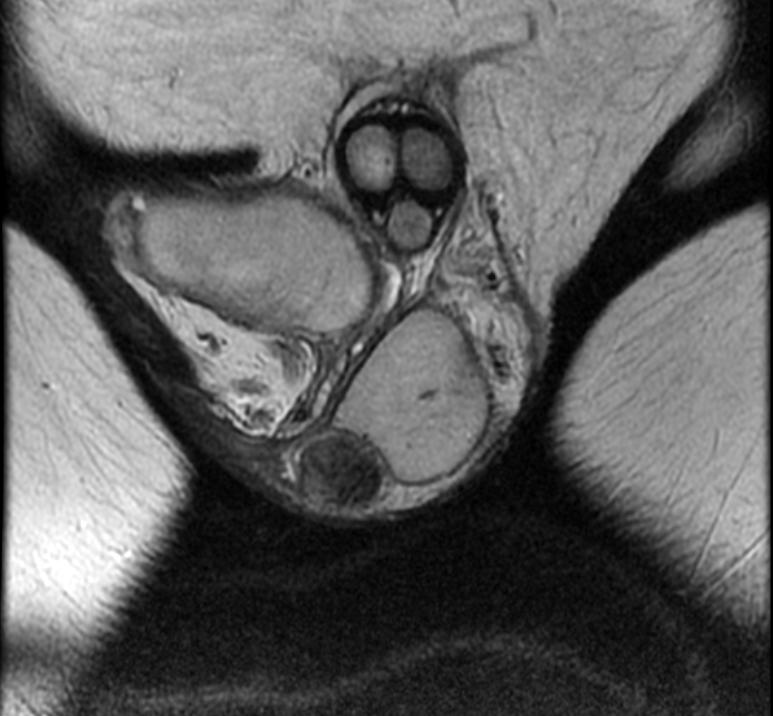 |
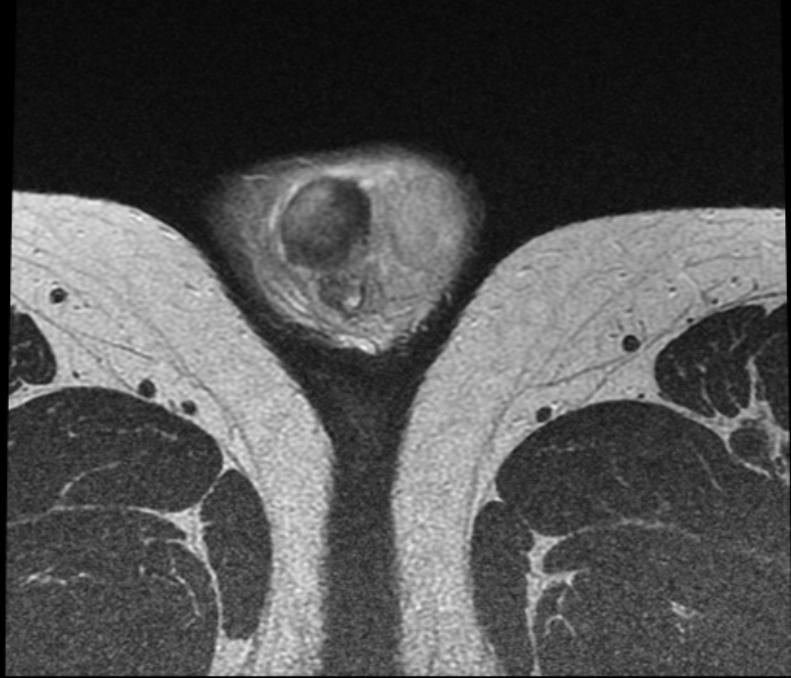 |
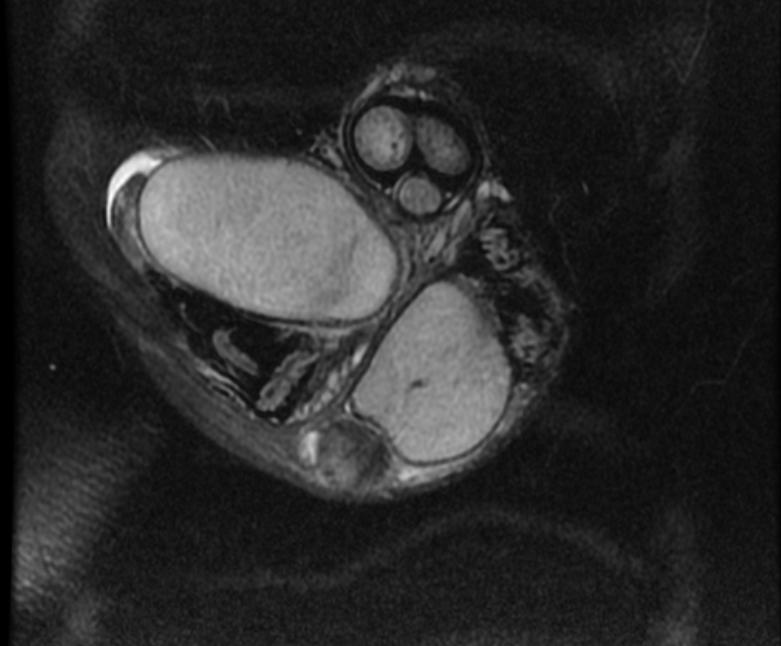 |
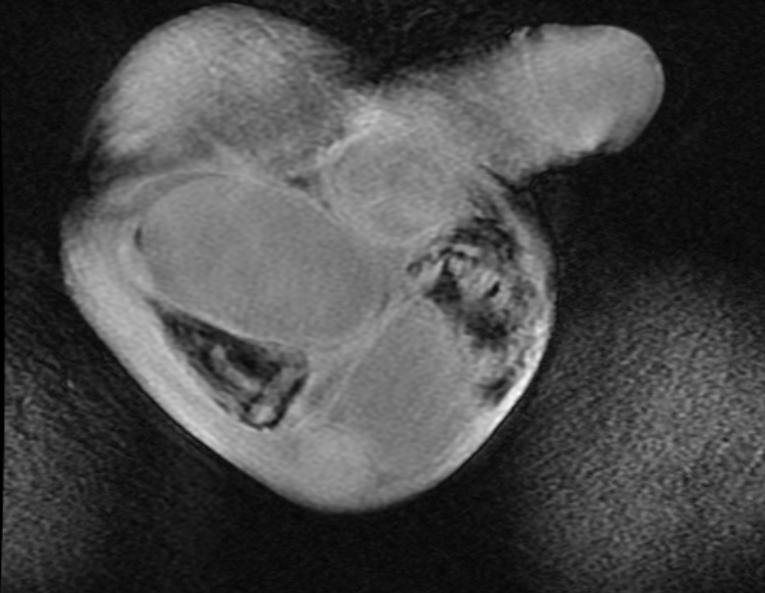 |
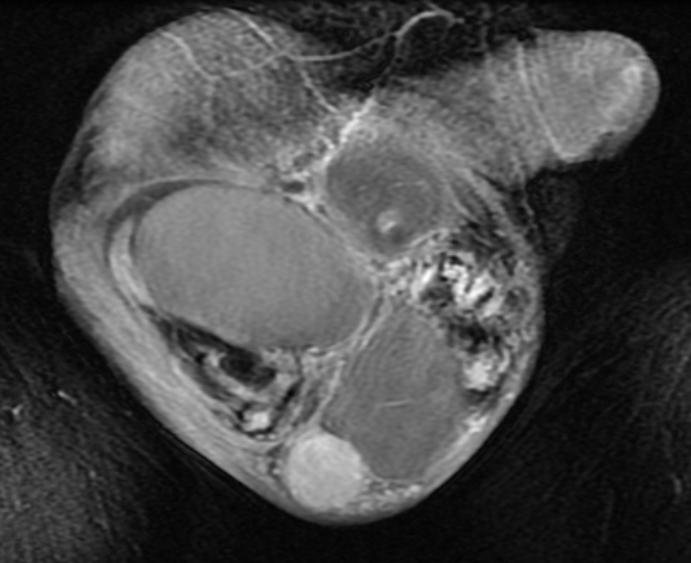 |
| Organ | Gross appearance | Histopathology | Immunohistochemical staining | Radiological features |
|---|---|---|---|---|
| Liver (cystic type) |
|
Cystic spaces having following characteristics:
|
Stains positive for:
|
MRI characteristics of adenomatoid tumor of liver are as follows:
|
| Mesocolon and omentum |
|
Stains positive for:
|
CT characteristics of adenomatoid tumor of mesocolon and omentum are as follows:
| |
| Adrenal gland (tubules and glands) | Appears as either: |
|
Stains positive for:
Stains negative for:
|
CT shows:
MRI shows:
|
| Pancreas (solid variant, usually cystic type) |
|
Stains positive for:
Stains negative for:
|
CT of adenomatoid tumor of pancreas shows:
| |
| Uterus |
|
|
Stains positive for:
|
MRI characteristics of adenomatoid tumor of uterus are as follows:
|
| Ovary |
|
Stains positive for:
Stains negative for:
|
CT shows:
|
Treatment
- Complete excision
- Frozen section examination may prevent unnecessary radical orchiectomy[73][74]
- Paratesticular tumors are rare tumors that are difficult to diagnose preoperatively and therefore, many patients are subjected to inguinal orchiectomy. However, radical orchiectomy can be avoided as the diagnosis of paratesticular tumor can be made on the basis of clinical suspicion, findings of tumor markers and radiological tests.
Differentiating Adenomatoid tumor from other diseases
- Adenomatoid tumor must be differentiated from:
- Malignant mesothelioma (HBME1+, mitoses and necrosis)
- Metastatic adenocarcinoma (positive for one or more of CEA, PSA, MOC31 / BerEP4 and CD15 are useful)
- Papillary cystadenoma of epididymis
References
- ↑ Amin W, Parwani AV (2009). "Adenomatoid tumor of testis". Clin Med Pathol. 2: 17–22. PMC 2990235. PMID 21151545.
- ↑ Williams SB, Han M, Jones R, Andrawis R (2004). "Adenomatoid tumor of the testes". Urology. 63 (4): 779–81. doi:10.1016/j.urology.2003.11.035. PMID 15072910.
- ↑ 3.0 3.1 Alam K, Maheshwari V, Varshney M, Aziz M, Shahid M, Basha M; et al. (2011). "Adenomatoid tumour of testis". BMJ Case Rep. 2011. doi:10.1136/bcr.01.2011.3790. PMC 3063256. PMID 22707658.
- ↑ "Adenomatoid tumor of the epididymis". Retrieved 2007-12-15.
- ↑ 5.0 5.1 Migliorini F, Baldassarre R, Artibani W, Martignoni G, Brunelli M (2014). "Rare case of intra-testicular adenomatoid tumour". Arch Ital Urol Androl. 86 (1): 44–5. doi:10.4081/aiua.2014.1.44. PMID 24704932.
- ↑ 6.0 6.1 Oyama H, Ogawa M, Mikuriya H, Kido A, Hayashi H (2001). "[Adenomatoid tumor of testicular tunica albuginea: a case report]". Hinyokika Kiyo. 47 (9): 661–3. PMID 11692607.
- ↑ Shima M, Takahashi S, Maeda T, Masumori N, Itoh N, Tsukamoto T (2009). "[Adenomatoid tumor of the testis with testicular pain: a case report]". Hinyokika Kiyo. 55 (5): 285–6. PMID 19507549.
- ↑ 8.0 8.1 Kalyani R, Das S (2009). "Adenomatatoid tumor: Cytological diagnosis of two cases". J Cytol. 26 (1): 30–2. doi:10.4103/0970-9371.54865. PMC 3167987. PMID 21938146.
- ↑ Barry P, Chan KG, Hsu J, Quek ML (2005). "Adenomatoid tumor of the tunica albuginea". Int J Urol. 12 (5): 516–8. doi:10.1111/j.1442-2042.2005.01091.x. PMID 15948758.
- ↑ 10.0 10.1 Chen D, Yu Z, Ni L, Gui Y, Yang S, Shi B; et al. (2014). "Adenomatoid tumors of the testis: A report of two cases and review of the literature". Oncol Lett. 7 (5): 1718–1720. doi:10.3892/ol.2014.1938. PMC 3997688. PMID 24765207.
- ↑ 11.0 11.1 Alexiev BA, Xu LF, Heath JE, Twaddell WS, Phelan MW (2011). "Adenomatoid tumor of the testis with intratesticular growth: a case report and review of the literature". Int J Surg Pathol. 19 (6): 838–42. doi:10.1177/1066896911398656. PMID 21427102.
- ↑ "Modern Pathology - Adenomatoid Tumor of the Pancreas: A Case Report with Comparison of Histology and Aspiration Cytology". Retrieved 2007-12-15.
- ↑ 13.0 13.1 13.2 Samad AA, Pereiro B, Badiola A, Gallego C, Zungri E (1996). "Adenomatoid tumor of intratesticular localization". Eur Urol. 30 (1): 127–8. PMID 8854081.
- ↑ Pichler R, Tulchiner G, Steinkohl F, Soleiman A, Horninger W, Heidegger IM; et al. (2018). "Adenomatoid tumor of the testis mimicking malignant testicular cancer on multiparametric ultrasound". Eur J Med Res. 23 (1): 3. doi:10.1186/s40001-018-0301-5. PMC 5765709. PMID 29325584.
- ↑ 15.0 15.1 Makkar M, Dayal P, Gupta C, Mahajan N (2013). "Adenomatoid tumor of testis: A rare cytological diagnosis". J Cytol. 30 (1): 65–7. doi:10.4103/0970-9371.107519. PMC 3643368. PMID 23661947.
- ↑ Taxy JB, Battifora H, Oyasu R (1974). "Adenomatoid tumors: a light microscopic, histochemical, and ultrastructural study". Cancer. 34 (2): 306–16. doi:10.1002/1097-0142(197408)34:2<306::aid-cncr2820340214>3.0.co;2-g. PMID 4277347.
- ↑ Quigley JC, Hart WR (1981). "Adenomatoid tumors of the uterus". Am J Clin Pathol. 76 (5): 627–35. doi:10.1093/ajcp/76.5.627. PMID 7293978.
- ↑ Yo H, Mori O, Ohaki Y, Kawamura T, Asano G (1996). "[Three cases of adenomatoid tumor of the uterus]". Nihon Ika Daigaku Zasshi. 63 (4): 294–8. PMID 8810558.
- ↑ Cheng CL, Wee A (2003). "Diffuse uterine adenomatoid tumor in an immunosuppressed renal transplant recipient". Int J Gynecol Pathol. 22 (2): 198–201. PMID 12649678.
- ↑ Otis CN (1996). "Uterine adenomatoid tumors: immunohistochemical characteristics with emphasis on Ber-EP4 immunoreactivity and distinction from adenocarcinoma". Int J Gynecol Pathol. 15 (2): 146–51. PMID 8786204.
- ↑ Gupta S, Garg S, Agarwal R, Sen R (2012). "Aspiration cytology of adenomatoid tumor of epididymis: An important diagnostic tool". J Surg Case Rep. 2012 (4): 11. doi:10.1093/jscr/2012.4.11. PMC 3649525. PMID 24960828.
- ↑ 22.0 22.1 Monappa V, Rao AC, Krishnanand G, Mathew M, Garg S (2009). "Adenomatoid tumor of tunica albuginea mimicking seminoma on fine needle aspiration cytology: a case report". Acta Cytol. 53 (3): 349–52. doi:10.1159/000325324. PMID 19534283.
- ↑ Marcus JB, Lynn JA (1970). "Ultrastructural comparison of an adenomatoid tumor, lymphangioma, hemangioma, and mesothelioma". Cancer. 25 (1): 171–5. doi:10.1002/1097-0142(197001)25:1<171::aid-cncr2820250125>3.0.co;2-2. PMID 5410308.
- ↑ Beccia DJ, Krane RJ, Olsson CA (1976). "Clinical management of non-testicular intrascrotal tumors". J Urol. 116 (4): 476–9. doi:10.1016/s0022-5347(17)58867-9. PMID 802862.
- ↑ Liu W, Wu RD, Yu QH (2011). "Adenomatoid tumor of the testis in a child". J Pediatr Surg. 46 (10): E15–7. doi:10.1016/j.jpedsurg.2011.06.020. PMID 22008356.
- ↑ Morote J, Rabella A, Benasco C (1984). "[Adenomatoid tumor of the epididymis]". Arch Esp Urol. 37 (1): 61–4. PMID 6721596.
- ↑ 27.0 27.1 Chaves RRM, Júnior AACP, Gomes CC, de Castro WH, Gomez RS (2019). "Multiple adenomatoid odontogenic tumors in a patient with Schimmelpenning syndrome". Oral Surg Oral Med Oral Pathol Oral Radiol. doi:10.1016/j.oooo.2019.06.006. PMID 31402313.
- ↑ Schwartz EJ, Longacre TA (2004). "Adenomatoid tumors of the female and male genital tracts express WT1". Int J Gynecol Pathol. 23 (2): 123–8. PMID 15084840.
- ↑ Gupta S, Erickson LA (2016). "Paratesticular Adenomatoid Tumor". Mayo Clin Proc. 91 (12): e167–e168. doi:10.1016/j.mayocp.2016.06.019. PMID 27916162.
- ↑ Medina Pérez M, Sánchez González M (1998). "[Paratesticular adenomatoid tumor, presentation as epididymal pain]". Arch Esp Urol. 51 (1): 88–90. PMID 9557344.
- ↑ Sánchez Gómez E, Huesa Martínez JI, Pérez Pérez M, Campoy Moreno JR (1995). "[Adenomatoid tumor of the epididymis. Report of a new case]". Arch Esp Urol. 48 (6): 643–5. PMID 7661645.
- ↑ Garrido Abad P, Jiménez Gálvez M, Herranz Fernández LM, Bocardo Fajardo G, Arellano Gañán R, Pereira Sanz I (2007). "[Adenomatoid tumor of the epididymis. Report of two cases]". Arch Esp Urol. 60 (6): 700–3. PMID 17847749.
- ↑ Moyano Calvo JL, Giraldez Puig J, Sánchez de la Vega J, Dávalos Casanova G, Morales López A (2007). "[Adenomatoid tumor of the epididymis]". Actas Urol Esp. 31 (4): 417–9. PMID 17633930.
- ↑ Llarena Ibarguren R, Rodríguez JG, Olano Grasa I, Azurmendi Arín I, Cantón Aller E, Pertusa Peña C (2008). "[Adenomatoid tumor of the epididymis. Report of five cases]". Arch Esp Urol. 61 (7): 831–4. PMID 18972922.
- ↑ Patoulias I, Kaselas C, Patoulias D, Theocharides C, Kalogirou M, Farmakis K; et al. (2016). "Epididymal Adenomatoid Tumor: A Very Rare Paratesticular Tumor of Childhood". Case Rep Med. 2016: 9539378. doi:10.1155/2016/9539378. PMC 5149645. PMID 28003830.
- ↑ Cabral Ribeiro J, Sousa L, Gonçalves V (2018). "[Tunica albuginea adenomatoid tumor. A challenging case managed conservatively]". Rev Int Androl. 16 (2): 82–86. doi:10.1016/j.androl.2017.02.008. PMID 30300129.
- ↑ Sun AY, Polackwich AS, Sabanegh ES (2016). "Adenomatoid Tumor of the Testis Arising From the Tunica Albuginea". Rev Urol. 18 (1): 51–3. PMC 4859931. PMID 27162515.
- ↑ Pacheco AJ, Torres JL, de la Guardia FV, Arrabal Polo MA, Gómez AZ (2009). "Intraparenchymatous adenomatoid tumor dependent on the rete testis: A case report and review of literature". Indian J Urol. 25 (1): 126–8. doi:10.4103/0970-1591.45551. PMC 2684313. PMID 19468443.
- ↑ Yang LH, Yu JH, Xu HT, Lin XY, Liu Y, Miao Y; et al. (2014). "Mesothelioma of the tunica vaginalis testis with prominent adenomatoid features: a case report". Int J Clin Exp Pathol. 7 (10): 7082–7. PMC 4230092. PMID 25400801.
- ↑ Gorini G, Pinelli M, Sforza V, Simi U, Rinnovati A, Zocchi G (2005). "Mesothelioma of the tunica vaginalis testis: report of 2 cases with asbestos occupational exposure". Int J Surg Pathol. 13 (2): 211–4. doi:10.1177/106689690501300214. PMID 15864387.
- ↑ Shen PR, Cen J, Qian XQ, Shen YM, Cheng XD, Wan XY (2019). "Synchronous occurrence of benign mesothelioma and adenomatoid tumor of uterus: A case report and review of literature". Medicine (Baltimore). 98 (20): e15746. doi:10.1097/MD.0000000000015746. PMC 6531052 Check
|pmc=value (help). PMID 31096539. - ↑ Manucha V, Azar A, Shwayder JM, Hudgens JL, Lewin J (2015). "Cystic adenomatoid tumor of the uterus". J Cancer Res Ther. 11 (4): 967–9. doi:10.4103/0973-1482.163678. PMID 26881558.
- ↑ Dietterle S, Hantschick M, Stosiek P (1997). "[Adenomatoid tumor of the uterus--2 case reports]". Zentralbl Gynakol. 119 (2): 82–5. PMID 9139502.
- ↑ 44.0 44.1 Butterwegge M, Krech R, Ohlenroth G (1995). "[The so-called adenomatoid tumor of the uterus: a case report of evaluation of primary sterility]". Geburtshilfe Frauenheilkd. 55 (1): 53–5. doi:10.1055/s-2007-1022774. PMID 7535715.
- ↑ Leaha C, Opris I, Macé P, Resch B, Sabourin JC (2009). "[Cystic adenomatoid tumor of the uterus]". Ann Pathol. 29 (2): 134–7. doi:10.1016/j.annpat.2008.10.001. PMID 19364588.
- ↑ Rappa F, Ternullo MP (2006). "[Adenomatoid tumor]". Pathologica. 98 (2): 164–6. PMID 16929792.
- ↑ Sarma NH, Srinivasulu M, Suchitra MJ (2014). "Leiomyoadenomatoid tumor of the uterus: report of a rare entity and review of the literature". Indian J Pathol Microbiol. 57 (3): 450–2. doi:10.4103/0377-4929.138759. PMID 25118743.
- ↑ Amérigo J, Amérigo-Góngora M, Giménez-Pizarro A, Velasco FJ, Gallardo SP, González-Cámpora R (2010). "Leiomyo-adenomatoid tumor of the uterus: a distinct morphological entity?". Arch Gynecol Obstet. 282 (4): 451–4. doi:10.1007/s00404-010-1383-7. PMID 20157717.
- ↑ Cazorla A, Algros MP, Bedgedjian I, Chabannes E, Camparo P, Valmary-Degano S (2014). "Epididymal Leiomyoadenomatoid Tumor: A Case Report and Review of Literature". Curr Urol. 7 (4): 195–8. doi:10.1159/000365675. PMC 4483293. PMID 26195950.
- ↑ 50.0 50.1 Sakurai N, Yamamoto Y, Asakawa Y, Taoka H, Takahashi K, Kubushiro K (2011). "Laparoscopically resected uterine adenomatoid tumor with coexisting endometriosis: case report". J Minim Invasive Gynecol. 18 (2): 257–61. doi:10.1016/j.jmig.2010.11.009. PMID 21354075.
- ↑ 51.0 51.1 Kalidindi M, Odejinmi F (2010). "Laparoscopic excision of uterine adenomatoid tumour: two cases and literature review". Arch Gynecol Obstet. 281 (2): 311–5. doi:10.1007/s00404-009-1114-0. PMID 19434414.
- ↑ Cserni G, Kocsis L, Pusztai Z, Godó G (2003). "Endometrial adenocarcinoma with coexisting adenomatoid tumor of the uterus". Gynecol Oncol. 90 (1): 207–10. PMID 12821367.
- ↑ Goto M, Uchiyama M, Kuwabara K (2016). "Adenomatoid tumor of the mediastinum". Gen Thorac Cardiovasc Surg. 64 (1): 47–50. doi:10.1007/s11748-014-0419-5. PMID 24839257.
- ↑ Parekh V, Winokur T, Cerfolio RJ, Stevens TM (2016). "Posterior Mediastinal Adenomatoid Tumor: A Case Report and Review of the Literature". Case Rep Pathol. 2016: 6898526. doi:10.1155/2016/6898526. PMC 4875993. PMID 27293940.
- ↑ Plaza JA, Dominguez F, Suster S (2004). "Cystic adenomatoid tumor of the mediastinum". Am J Surg Pathol. 28 (1): 132–8. PMID 14707875.
- ↑ Minato H, Nojima T, Kurose N, Kinoshita E (2009). "Adenomatoid tumor of the pleura". Pathol Int. 59 (8): 567–71. doi:10.1111/j.1440-1827.2009.02407.x. PMID 19627540.
- ↑ Galateau-Sallé F, Vignaud JM, Burke L, Gibbs A, Brambilla E, Attanoos R; et al. (2004). "Well-differentiated papillary mesothelioma of the pleura: a series of 24 cases". Am J Surg Pathol. 28 (4): 534–40. PMID 15087673.
- ↑ Hiroshima K, Yusa T, Kameya T, Ito I, Kaneko K, Kadoyama C; et al. (2009). "Malignant pleural mesothelioma: clinicopathology of 16 extrapleural pneumonectomy patients with special reference to early stage features". Pathol Int. 59 (8): 537–45. doi:10.1111/j.1440-1827.2009.02404.x. PMID 19627537.
- ↑ Torii I, Hashimoto M, Terada T, Kondo N, Fushimi H, Shimazu K; et al. (2010). "Well-differentiated papillary mesothelioma with invasion to the chest wall". Lung Cancer. 67 (2): 244–7. doi:10.1016/j.lungcan.2009.10.004. PMID 19880210.
- ↑ Mohanty R, Singh V, Dey AK, Behera S (2019). "A rare nonsyndromic case of adenomatoid odontogenic tumor associated with multiple impacted supernumerary teeth". Natl J Maxillofac Surg. 10 (1): 114–117. doi:10.4103/njms.NJMS_25_18. PMC 6563630 Check
|pmc=value (help). PMID 31205401. - ↑ Dhirawani RB, Pathak S, Mallikaarjuna K, Sharma A (2016). "An adenomatoid odontogenic tumor in disguise". J Indian Soc Pedod Prev Dent. 34 (3): 291–3. doi:10.4103/0970-4388.186752. PMID 27461816.
- ↑ Bravo M, White D, Miles L, Cotton R (2005). "Adenomatoid odontogenic tumor mimicking a dentigerous cyst". Int J Pediatr Otorhinolaryngol. 69 (12): 1685–8. doi:10.1016/j.ijporl.2005.03.055. PMID 15996761.
- ↑ Sethi S, Kumar M, Aggarwal P, Indra Kumar HS, Sugandhi CD, Singh S (2016). "A case report and short review on changing trends in the site of occurrence of adenomatoid odontogenic tumor: Unravelling the past 15 years". Dent Res J (Isfahan). 13 (5): 462–471. PMC 5091007. PMID 27857774.
- ↑ Dwivedi D, Prabhakar N, Kasetty S, Ahuja R (2019). "Peripheral adenomatoid odontogenic tumor in a cloak of an epulis: report of a rare case". BMC Oral Health. 19 (1): 81. doi:10.1186/s12903-019-0759-8. PMC 6511215 Check
|pmc=value (help). PMID 31077195. - ↑ Yeh CJ, Chuang WY, Chou HH, Jung SM, Hsueh S (2008). "Multiple extragenital adenomatoid tumors in the mesocolon and omentum". APMIS. 116 (11): 1016–9. doi:10.1111/j.1600-0463.2008.01084.x. PMID 19133002.
- ↑ Liu YC, Kuo YL, Yu CP, Wu HS, Yu JC, Chen CJ; et al. (2004). "Primary malignant mesothelioma of the greater omentum: report of a case". Surg Today. 34 (9): 780–3. doi:10.1007/s00595-004-2809-2. PMID 15338355.
- ↑ Malpica A, Sant'Ambrogio S, Deavers MT, Silva EG (2012). "Well-differentiated papillary mesothelioma of the female peritoneum: a clinicopathologic study of 26 cases". Am J Surg Pathol. 36 (1): 117–27. doi:10.1097/PAS.0b013e3182354a79. PMID 22024662.
- ↑ Delahunt B, Eble JN, King D, Bethwaite PB, Nacey JN, Thornton A (2000). "Immunohistochemical evidence for mesothelial origin of paratesticular adenomatoid tumour". Histopathology. 36 (2): 109–15. doi:10.1046/j.1365-2559.2000.00825.x. PMID 10672054.
- ↑ Delahunt B, Eble JN, Nacey JN, Thornton A (2001). "Immunohistochemical evidence for mesothelial origin of paratesticular adenomatoid tumour". Histopathology. 38 (5): 479. doi:10.1046/j.1365-2559.2001.1163a.x. PMID 11422488.
- ↑ Isotalo PA, Yazdi HM, Perkins DG, Mai KT (2000). "Immunohistochemical evidence for mesothelial origin of paratesticular adenomatoid tumour". Histopathology. 37 (5): 476–7. doi:10.1046/j.1365-2559.2000.09737.x. PMID 11119138.
- ↑ Ferenczy A, Fenoglio J, Richart RM (1972). "Observations on benign mesothelioma of the genital tract (adenomatoid tumor). A comparative ultrastructural study". Cancer. 30 (1): 244–60. doi:10.1002/1097-0142(197207)30:1<244::aid-cncr2820300135>3.0.co;2-c. PMID 5040745.
- ↑ Urkmez A, Akan S, Ozsoy E, Sahin A, Koca O, Ozturk MI (2018). "Diagnosis and Treatment of Paratesticular Adenomatoid Tumors". J Coll Physicians Surg Pak. 28 (9): S217–S219. doi:10.29271/jcpsp.2018.09.S217. PMID 30173704.
- ↑ Goel A, Jain A, Dalela D (2011). "Can radical orchiectomy be avoided for paratesticular adenomatoid tumor?". Indian J Urol. 27 (4): 556–7. doi:10.4103/0970-1591.91454. PMC 3263233. PMID 22279331.
- ↑ Subik MK, Gordetsky J, Yao JL, di Sant'Agnese PA, Miyamoto H (2012). "Frozen section assessment in testicular and paratesticular lesions suspicious for malignancy: its role in preventing unnecessary orchiectomy". Hum Pathol. 43 (9): 1514–9. doi:10.1016/j.humpath.2011.11.013. PMID 22406369.